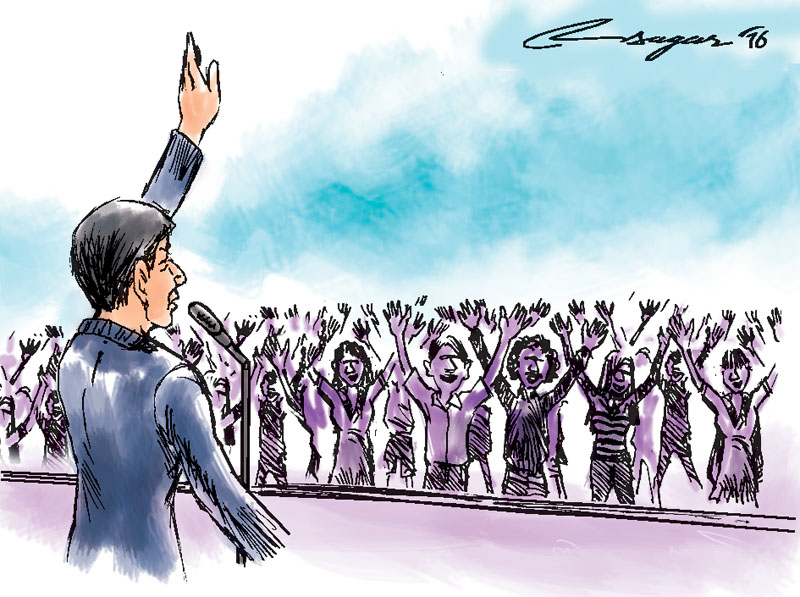Building political image: Exercise caution
Management of reputation is crucial for every leader. The government depends upon the people mainly for public approval. The functions of informing, persuading and integrating people are the fundamentals of pro-public politics
India and Pakistan were locked in a tug-of-war. In January 2002, amidst the height of tensions between the two neighbouring countries, Pakistan’s President General Pervez Musharraf and India’s Prime Minister Atal Bihari Vajpayee arrived in Kathmandu to participate in 11th SAARC summit. During the inaugural session, immediately after completing his speech, General Musharraf impromptu walked over to the Indian PM and the two leaders shook hands.
By the performance of this act of non-verbal communication, the General conveyed a message to the world. The Pakistani media used the event to boost his image as the initiator for peace in the region. They stated that the general forced the Indian prime minister to rise and shake hands with him, a move that many believe could help deter the two countries from their untenable logic of war. Although it was momentary, the act gained currency.
Political leaders, encircled by seasoned public relations and media experts, choreograph events in order to establish their image in a positive light before the general public. Working within a press and publicity environment, a public relations expert or a media adviser is responsible for generating favourable media coverage to build awareness of events amongst key stakeholders, generally the wider range of public sphere.
Proper conduct of public relations enhances the reputation of a leader either they be political, business or spiritual in any society. Messages are to be designed for delivery to specific audience, and their reception and potential impact are to be researched.
Politics, at its heart, is about communication between an organization or a leader and the public, between the government and the electorate. The twenty-first century public relations—with the advent of new media—is embedded in everything from politics and business to celebrity and spiritual activities. Now, it firmly lies at the heart of a strategic planning.
It is obvious that leaders intend to create planned public reactions out of their communication. However, it is not so simple and thus not possible to plan the public’s reaction to anything all the time. For example, some people in Nepal became annoyed and considered Prime Minister KP Sharma Oli’s speech in January 2016 as a joke, amidst an acute fuel crisis, when the latter spoke at a public meeting pledging that soon he would manage the supply of Liquid Petroleum Gas through pipelines to every household. The news media diffused the audio-visual with his unique gesture-posture and body language virtually in real time. It further posed a question over his image as one who resorted to off-the-cuff remarks and light talk.
Later, his team members tried to control damage over his image and claimed that the government has already started the home work to provide LPG through the pipelines. However, it was the situation where the cart was placed before the horse. The prime minister could have avoided agony, mistrust, and hue and cry in the public with a well-planned way of persuasion through his public speech. To the contrary, the boomerang effect—a non-conducive social psychology against his image—occurred. Even if he might have presented a persuasive message, the effect was opposite to the intended drive.
One can use common sense and attempt to provoke a reaction to a certain stimulus, but nothing is assured in the context of public reaction. However, effective public relations skills equip a leader to keep control over a political atmosphere. Thus, an appropriate way of making public announcement distinguished a public leader from an ordinary person making trivial remarks.
Management of reputation is crucial for every leader. The government depends upon the people mainly for public approval. The functions of informing, persuading and integrating people are the fundamentals of pro-public politics. The skilled communication of a government’s policies and programmes to the public build a bridge of goodwill between the two.
Over the years, the mass media have come to play a central role in socio-economic and political lives. Thus, the leaders need to use them to disseminate their message to the general public. A skillful act of communication results in providing mirror to them where they can examine their image. Successful communication requires an understanding of the mass media and healthy doses of common sense and imagination. And all that might not be enough without some control over the actions and words of the leaders.
Public relations, when done well, in order to create an atmosphere of favourable public communication, contributes to social consensus. However, professional mass media entertain an event, incident or message that fits to the determinants of news. Thus, effective public relation is the consequence of addressing the quest of news values determined by professional journalism.
A major portion of public communication could be performed by professional indulgence with the mass media. With the skills to cultivate a favourable coverage of a leader, whether political, business, social or spiritual, could build a base for popularity out of an overarching love-hate relationship with the skeptical mass media that serve as an important social entity.






